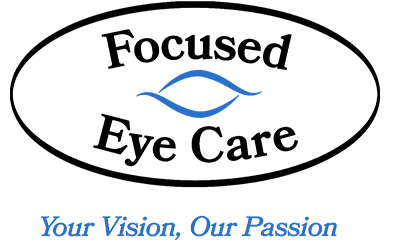At Focused Eye Care, we try to stress the importance of eye exams to all of our patients, in order to catch any eye health conditions before they develop.
Refractive Errors
Myopia (AKA “near sighted”)
This is a normal refractive condition in which the eyes are able to focus up close but are not able to see clearly far away. Myopia normally progresses through childhood and the teen years while the eyes are growing. It is common for the strength of the lens to increase every year during this period, so it is important for children to have yearly eye exams. Sometime in the mid-twenties, the prescription usually stabilizes as the eyes stop growing. With high myopic prescriptions, it is important to have the eyes dilated every two years to monitor for thinning of the peripheral retina, the inner lining of the eye where the vision cells are located, which can occur due to the increased length of myopic eyes. Myopic prescriptions are written with a negative sign and can be corrected with either glasses or contact lenses.
Hyperopia (AKA “far sighted”)
This is a normal refractive condition in which the eyes are more easily able to focus at distance than up close. For many people with hyperopia, the visual system is able to completely focus through any prescription present. However, in the late thirties, it may become necessary to correct this error to alleviate eye strain and fatigue, especially with extended computer use. Also, in some children, it may be necessary to correct this error to aid in reading and school work. Because hyperopia often does not create blurry vision, children may not want to nor feel the need to wear the correction. Without their correction however, headaches often develop as well as poor reading skills. It is therefore important for these children to wear the correction even if they resist. Hyperopic prescriptions are written with a positive sign and can be corrected with either glasses or contact lenses.
Astigmatism
Often described as a “football-shaped eye,” this normal refractive condition causes blurry vision at all distances, particularly in low lighting and at night. A spherical (non-astigmatism) eye will have one focal point, as the sun through a magnifying glass has one bright point. An astigmatic eye however, has two focal points due to the two distinct curvatures of the “football-shaped eye.” The two images overlap in a way that does not create double vision but creates blur. With the appropriate correction, the two images are brought into alignment thus creating one clear image. An astigmatic prescription is written with an axis or “X”, which is the positioning of the two corrections and can be corrected with either glasses or contact lenses. Learn More about Astigmatism.
Presbyopia (the need for bifocals)
This condition is often incorrectly associated with old age, but this is not necessarily true. Presbyopia is a normal physiologic change occurring in every human during their late 30’s or early to mid 40’s. This condition occurs as the lens inside the eye, which normally focuses up close for us and relaxes for distance, starts losing its focusing ability by becoming more rigid. The more rigid the lens gets the less it is able to change shape and allow us to focus up close, so a reading power must be used. The standard correction for this is either a bifocal or reading glasses, but there are many alternatives. Progressive lenses (no-line bifocals) are more cosmetically appealing as well as more functional because they provide an increased range of clear vision including at distance, at a computer screen, and up close. Another good choice for correcting this condition is multifocal contacts lenses. These lenses provide clear vision at all distances without the need to rely on “cheaters”.
Binocular Problems
Binocular vision problems are most often congenital in nature. Because of this they can be detected and treated early in life. Binocular vision problems manifest themselves as blurry vision, double vision, headaches, falling asleep while reading, poor attention, and poor grades in school. Because of their visual discomfort, many children with binocular vision problems develop poor attention. These children are then misdiagnosed as having behavioral problems and are often started on medication to help calm them down and focus. If these childrens’ vision problems can be detected and treated by a professional, attention may improve without the help of a medication.
There are four main treatments for binocular vision problems. The first is wearing the appropriate spectacle prescription. This alone may solve many binocular anomalies. The second is the use of prism, which is a special prescription that is put into glasses to change the orientation of the image through the spectacles to alleviate any double vision or visual discomfort. The third is the use of visual therapy (VT). Vision therapy is very similar to physical therapy of the body. During VT, exercises are performed by the patient to increase their control of their visual system. The last treatment is surgery to permanently shift the eyes to the appropriate positions.
Multiple treatment options are often used together to provide the best outcome. For example, a patient may be prescribed prism to shift the images they see to eliminate double vision and also be started on a vision therapy program. As the patient gains better control of their visual system the prism is taken out of the spectacles and the patient is able to maintain a more comfortable and stable visual system.
At Focused Eye Care, on the Apple Valley and Lakeville border, our eye doctors measure for all of these visual anomalies to provide our patients with the best visual outcome.

